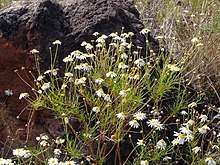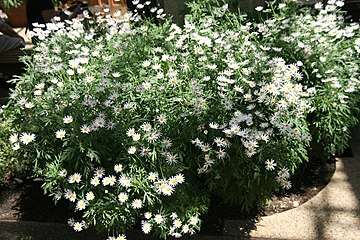Glebionidinae
Glebionidinae is a small subtribe of flowering plants in the tribe Anthemideae of the family Asteraceae. Its members include species used in the production of garden marguerites.
| Glebionidinae | |
|---|---|
 | |
| Argyranthemum gracile in Tenerife | |
| Scientific classification | |
| Kingdom: | Plantae |
| Clade: | Tracheophytes |
| Clade: | Angiosperms |
| Clade: | Eudicots |
| Clade: | Asterids |
| Order: | Asterales |
| Family: | Asteraceae |
| Tribe: | Anthemideae |
| Subtribe: | Glebionidinae Oberpr. & Vogt[1] |
| Genera | |
| Synonyms[1][2] | |
| |
Description
Members of the subtribe are either subshrubs (Argyranthemum) or annual herbs (the remaining genera). The genus Heteranthemis has glandular hairs; the others either lack hairs or have non-glandular hairs. The flower heads (capitula) are solitary or arranged in loose corymbs. The ray florets are female, the long petal (ligule) usually being white or yellow. The disc florets are bisexual with a five-lobed corolla. The achenes of the ray florets are three-angled and have two or three wings; those of the disc florets are flattened and have one or two wings.[2]
Taxonomy
The subtribe was first proposed in 1993 by Bremer and Humphries, under the name "Chrysantheminae". The name was validly published at the time, but two annual species placed in the tribe, which were then known as Chrysanthemum coronarium and Chrysanthemum segetum, are now placed in Glebionis.[2] (The genus Chrysanthemum is now used for perennial Asian species, such as the conserved type C. indicum.) Hence Chrysantheminae Bremer & Humphries became a later homonym of Chrysantheminae Less. and so illegitimate.[1] In 2007, Oberprieler and Vogt provided a new name, Glebionidinae, based on the genus Glebionis, whose type species is Glebionis coronaria, formerly Chrysanthemum coronarium.[2]
Genera
The subtribe comprises four genera:[2]
- Argyranthemum Webb, about 24 species
- Glebionis Cass., two species
- Heteranthemis Schott, one species
- Ismelia Cass., one species
Intergeneric hybrids are known:[3]
- ×Argyrimelia J.M.H.Shaw = Argyranthemum × Ismelia – artificial hybrids
- ×Glebianthemum J.M.Watson & A.R.Flores = Argyranthemum × Glebionis – artificial and spontaneous hybrids
- ×Glebianthemum valinianum J.M.Watson & A.R.Flores = A. frutescens × G. coronaria – discovered in Chile where both parents were naturalized and grew together; also produced artificially
- Glebionis × Ismelia – artificial hybrids
- Species and hybrids
- Argyranthem frutescens
 Glebionis coronaria var. discolor
Glebionis coronaria var. discolor_(8413243693)_rev.jpg) Illustration of Ismelia carinata
Illustration of Ismelia carinata Garden marguerite 'Vera'
Garden marguerite 'Vera'.jpg) Hybrid garden marguerite
Hybrid garden marguerite Hybrid garden marguerite
Hybrid garden marguerite
Phylogeny
A 2007 molecular phylogenetic study of the tribe Anthemideae found the subtribe Glebionidinae to be the most deeply nested. One species from each of the genera was included, producing the relationships within the subtribe shown below.[2]
| Glebionidinae |
| ||||||||||||||||||
The apparently close relationship between Glebionis and Ismelia is reflected in the decision by some sources to sink I. carinata into Glebionis as G. carinata.[4]
Distribution
Genera belonging to the subtribe are native to Macaronesia, Europe, northern Africa and southwestern Asia.[2]
Cultivation
Argyranthemum species, particularly Argyranthemum frutescens, have been in cultivation since at least the early 1700s.[5] Ismelia carinata, sometimes known as the annual chrysanthemum, is also cultivated. Particularly since the 1960s, intergeneric hybrids among the members of the subtribe have been used to introduce flowers of varied colours and forms into garden marguerites, used as bedding and container plants.[3]
References
- "Glebionidinae Oberpr. & Vogt", The International Plant Names Index, retrieved 2020-02-24
- Oberprieler, Christoph; Himmelreich, Sven & Vogt, Robert (2007), "A new subtribal classification of the tribe Anthemideae (Compositae)", Willdenowia, 37 (1): 89–114, doi:10.3372/wi.37.37104
- Flores, Anita; Shaw, Julian & Watson, John (2018), "Unpicking a daisy chain", The Plantsman, New Series, 17 (4): 238–243
- "Ismelia carinata (Schousb.) Sch.Bip. AUTH", Plants of the World Online, Royal Botanic Gardens, Kew, retrieved 2020-02-24
- Francisco-Ortega, J; Santos-Guerra, A.; Sánchez-Pinto, L. & Maunder, M. (2012), "Early cultivation of Macaronesian plants in three European botanic gardens", Revista de la Academia Canaria de Ciencias, 23: 113–143, S2CID 127850789